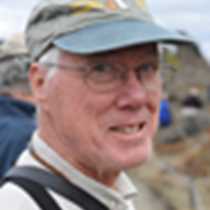The South Shetland Islands
Overnight we headed north across the Bransfield Straits to reach the South Shetland Islands. Between 1909 and 1932 this volcanic archipelago was a center for Antarctic whaling. In the first four seasons, alone, 17,583 humpback whales were killed for their oil-rich blubber. As humpback populations were quickly depleted the whalers turned their attention to the large blue and fin whales. Fortunately, the humpbacks now seem to be recovering, as evidenced by our early morning encounter near Deception Island. It was easy to see why humpbacks were such easy prey for whalers, as two whales made repeated feeding dives, seemingly oblivious to our approach. And thus we added a third whale species to our trip list.
We passed through Neptune’s Bellows to enter the flooded caldera of Deception Island. The island is an active volcano that last erupted in 1967, 1969 and 1970, causing evacuation of Chilean and British research stations. Volcanic heat continues to seep through the cinders, warming the water to the delight those who seek a swim ... well, more accurately a wallow ... along the edge of the bay. Endeavour was well represented by a large contingent of wallowers, the bravest of whom made a mad dash into the colder water and a hasty retreat to their warm depression in the cinders.
Our afternoon destination, Hannah Point on Livingston Island, gave us an opportunity to experience pungent, thigmotactic heaps of enormous elephant seals, and visit three penguin species: gentoos, a few macaronis adorned with long yellow plumes (“stuck a feather in his cap and called it ...”), and, seen above, feisty chinstraps. Their two eggs have become two downy chicks, and they are finding it increasingly difficult to fit under the attending parent (alternately, male or female, while the other is out seeking the next meal for the insistent young.) We watched the sequence of behaviors as the foraging adult returned from the sea, the two adults engaged in a vocal greeting, and they exchanged places on the nest. The returning adult immediately began feeding the chicks, and the adult now relieved from nest attendance waddled off to take its turn at foraging. And so it goes, trip after trip, as the chicks grow ever larger. The job is repetitive, but the view is superb!
Overnight we headed north across the Bransfield Straits to reach the South Shetland Islands. Between 1909 and 1932 this volcanic archipelago was a center for Antarctic whaling. In the first four seasons, alone, 17,583 humpback whales were killed for their oil-rich blubber. As humpback populations were quickly depleted the whalers turned their attention to the large blue and fin whales. Fortunately, the humpbacks now seem to be recovering, as evidenced by our early morning encounter near Deception Island. It was easy to see why humpbacks were such easy prey for whalers, as two whales made repeated feeding dives, seemingly oblivious to our approach. And thus we added a third whale species to our trip list.
We passed through Neptune’s Bellows to enter the flooded caldera of Deception Island. The island is an active volcano that last erupted in 1967, 1969 and 1970, causing evacuation of Chilean and British research stations. Volcanic heat continues to seep through the cinders, warming the water to the delight those who seek a swim ... well, more accurately a wallow ... along the edge of the bay. Endeavour was well represented by a large contingent of wallowers, the bravest of whom made a mad dash into the colder water and a hasty retreat to their warm depression in the cinders.
Our afternoon destination, Hannah Point on Livingston Island, gave us an opportunity to experience pungent, thigmotactic heaps of enormous elephant seals, and visit three penguin species: gentoos, a few macaronis adorned with long yellow plumes (“stuck a feather in his cap and called it ...”), and, seen above, feisty chinstraps. Their two eggs have become two downy chicks, and they are finding it increasingly difficult to fit under the attending parent (alternately, male or female, while the other is out seeking the next meal for the insistent young.) We watched the sequence of behaviors as the foraging adult returned from the sea, the two adults engaged in a vocal greeting, and they exchanged places on the nest. The returning adult immediately began feeding the chicks, and the adult now relieved from nest attendance waddled off to take its turn at foraging. And so it goes, trip after trip, as the chicks grow ever larger. The job is repetitive, but the view is superb!




